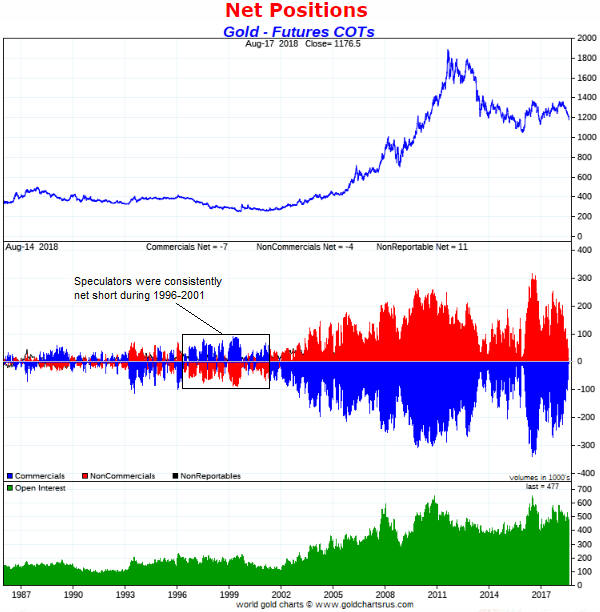Sentiment pitfalls, the gold edition
Posted By Steven Saville On August 20, 2018 @ 7:13 am In Uncategorized | Comments Disabled
In a couple of blog posts last year [1] I discussed the limitations of sentiment as a market timing tool. With the most reliable sentiment indicators now revealing extreme negativity towards gold, it’s timely to revisit this topic using the current gold market situation as an example.
There are two sentiment pitfalls that I mentioned in the earlier posts that are especially relevant to the current gold-market situation. The first is linked to the fact that sentiment generally follows price, making it a near certainty that the overall mood will be at an optimistic extreme near an important price top and a pessimistic extreme near an important price bottom. Putting it another way, there is nothing like a strongly-rising price to get the speculating community and the general public bullish and there is nothing like a steep price decline to get them bearish, so it’s perfectly natural that price-tops will be associated with optimism and price-bottoms will be associated with pessimism. The problem is that while an important price extreme will always be associated with a sentiment extreme, a sentiment extreme doesn’t necessarily imply an important price extreme.
Gold’s current Commitments of Traders (COT) situation shows that relative to the past 15 years, speculative sentiment is now at a pessimistic extreme. This implies that there is now plenty of sentiment-related fuel to propel the gold price upward over the months ahead, but it doesn’t imply that the price is close to a sustainable low. If the price continues to trend downward then speculators, as a group, will continue to lose interest in being long and gain interest in being short. Of course, when a sustainable price bottom is reached it WILL coincide with very negative sentiment, because, as I said, sentiment follows price.
The second potential pitfall is that what constitutes a sentiment extreme will vary over time, meaning that there are no absolute benchmarks. In particular, what constitutes dangerous optimism in a bear market will often not be a problem in a bull market and what constitutes extreme fear/pessimism in a bull market will often not signal a good buying opportunity in a bear market.
At the moment, gold is not in a bull market. It is either still immersed in the bear market that began in 2011 or immersed in a long-term basing pattern. Either way, it isn’t reasonable to blindly assume that what constituted a sentiment extreme during the period since 2001, the bulk of which involved a gold bull market, constitutes a sentiment extreme today.
If we look back further than 2001 we see that the current speculative positioning in gold futures is not necessarily indicative of an extreme. For example, the following chart from goldchartsrus.com [2] shows that speculators in Comex gold futures were consistently net-short during 1996-2001.
My guess is that the gold price will rebound strongly from whatever low it makes during August-September. However, unless the fundamentals make a sustainable turn in gold’s favour (right now the fundamental backdrop is unequivocally bearish for gold) it’s likely that at some future point the COT data for gold will reveal much greater negativity on the part of the speculating community than exists today.
Article printed from TSI Blog: https://tsi-blog.com
Click here to print.
